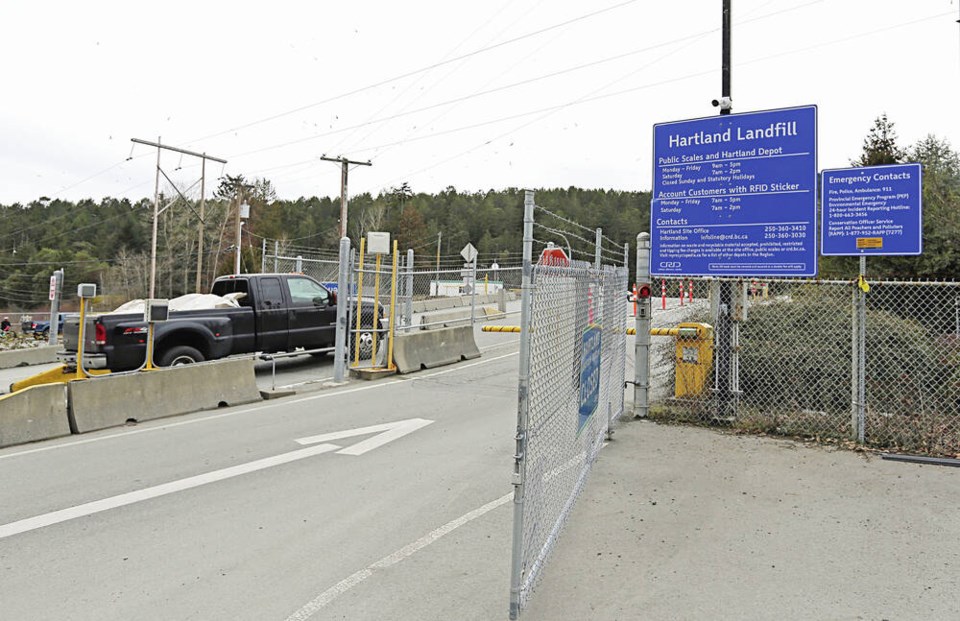Nearly half the waste going into Hartland Landfill is recyclable material that could have been diverted at the consumer level, says a new report to the Capital Regional District.
That’s a disturbing situation as the region looks to extend the life of the landfill to 2049 and in a best-case scenario, with potential incineration and gasification projects, to the turn of the next century.
But it’s not looking good at the current rate, said CRD chair Colin Plant. “What we’re seeing is certainly concerning,” Plant said Thursday. “It makes me realize that we have to do a lot more to make our targets of reducing waste.”
The CRD’s 2022 Waste Composition Study, conducted by Tetra Tech Canada over a three-week period last September, is done every five years for a snapshot of what residents and businesses are sending to the landfill. It’s a messy, hands-on business designed to guide diversion and education programs.
It found that 47% of the material received at Hartland could have been diverted at source through existing waste diversion or recycling programs.
The report is designed to help the CRD to achieve the targets set out in its 2021 Solid Waste Management Plan, which established a target of 250 kilograms of waste a year per capita by 2031. That’s a one-third reduction of the current rate of 400 kilograms per capita a year going into the landfill.
Barb Desjardins, chair of the environmental services committee, said despite all the efforts to reduce waste “we are still heading in the wrong direction in terms of what’s going into Hartland.”
Desjardins said the CRD has to work harder to bring municipalities outside the core into the sorting of garbage and organics. About 67% of organics found in garbage came from single-family homes and multifamily dwellings and 27% from industrial, commercial and institutional sources like restaurants and care centres.
Desjardins said there are also several options to encourage the recycling of wood products and construction debris, including deconstruction and other recycling methods.
She said the CRD is also considering gasification techniques, where construction materials and biosolids from sewage treatment would be burned, yielding synthetic fuel, electricity and bio char.
The garbage report noted that while organics in the landfill have been decreasing since a ban in 2016, green waste like table scraps and yard trimmings still accounts for 17% of landfilled waste — and remains the second-largest component of the waste stream at Hartland.
Wood and wood products are the largest material stream, accounting for 19% of total waste sent to Hartland Landfill.
The other two largest material categories are paper products, accounting for 14.2% of the total annual waste, and plastics, which make up 12.6% of the yearly dump at Hartland.
The largest swing upward was in construction and demolition materials, with an increase of 6.6% from the last study in 2016. Materials such as broken two-by-fours, plywood and treated lumber now account for 13.3% of the waste stream.
The report said the increase was likely due to an active real estate market and uptick in home renovations, as well as the closure of Highwest Landfill in the Highlands in 2021, when much of the material started to be routed to Hartland.
Household hygiene products accounted for 7% of the annual waste stream, followed by textiles at 5%, metals (3%), hazardous materials (1.6%) and tires (1.5%).
Russ Smith, the regional district’s senior manager of environmental resource management, said the CRD has bylaw officers at Hartland who monitor and enforce its tipping-fee bylaws. In 2022, enforcement resulted in $100,000 in fines, with the majority issued for improper disposal of recyclables and kitchen scraps at the active face of the landfill or at the public drop-off area.
The fines were issued to a mix of private haulers, municipal haulers and the general public, Smith said.
One controversial item that ended up in the landfill this year was 2,108 tonnes of biosolids, the end product of sewage treatment. The granular material accounted for 1.1% of the total waste stream.
The CRD had to landfill the biosolids after its only current client for the product, the Lafarge cement kiln in Richmond, went out of commission for almost all of 2022.
Lafarge informed the CRD this week that shipments of biosolids can resume starting April 1.
Under provincial law, the CRD is required to find beneficial uses for biosolids, including use on non-agricultural land as a fertilizer, and in a kiln as a coal replacement. Right now, landfilling biosolids isn’t legal, but the Environment Ministry has been allowing the CRD to landfill the biosolids while it tries to find a long-term solution such as gasification.
One short-term option is shipping the biosolids to the Regional District of Nanaimo to spread as a fertilizers on forestry lands.
In a report to the CRD board on Wednesday, staff said the regional district is moving forward with an amended short-term biosolids management plan to include application on non-agricultural land in the Regional District of Nanaimo. The report said CRD staff have now “formally engaged all stakeholders, including the Regional District of Nanaimo, and the landowner has engaged with the local First Nation.”
>>> To comment on this article, write a letter to the editor: [email protected]



